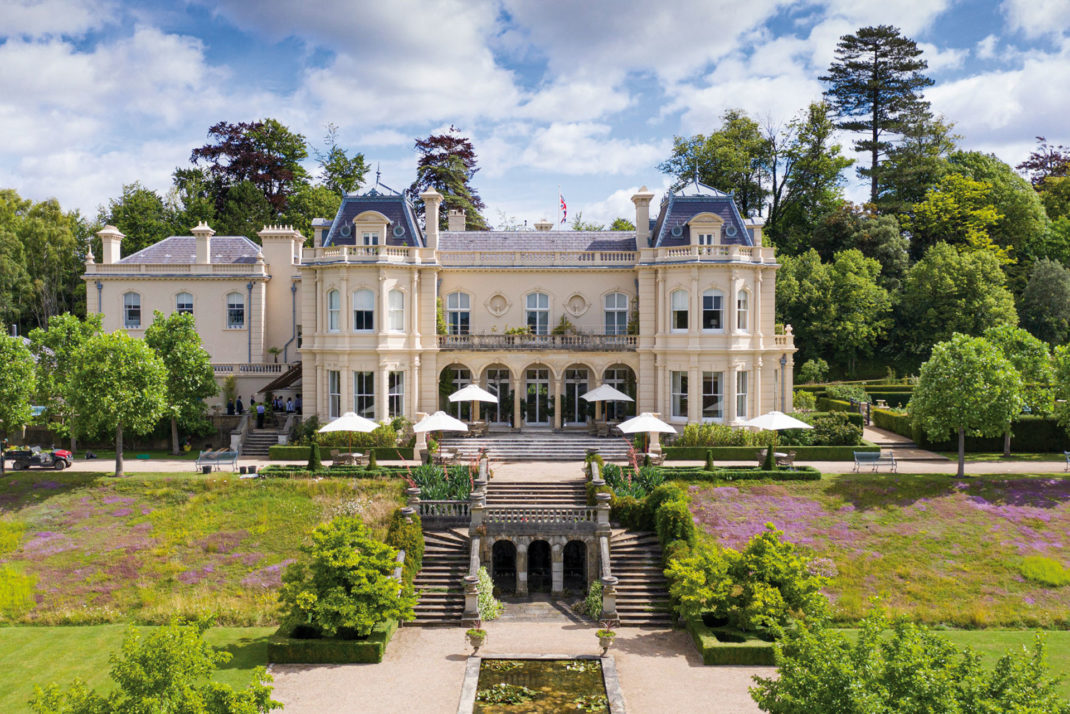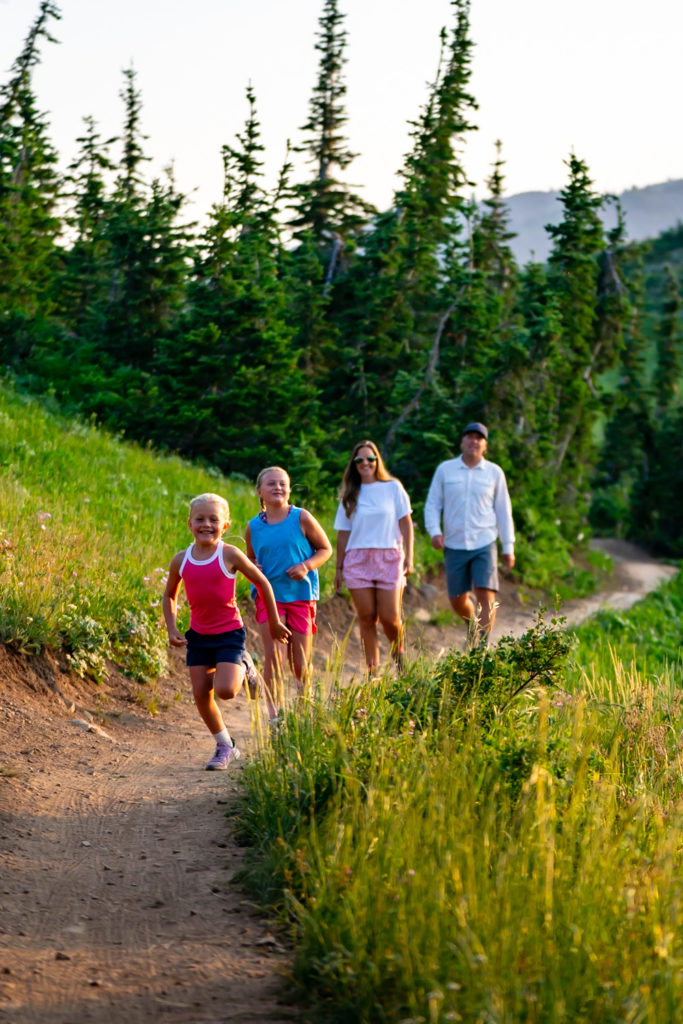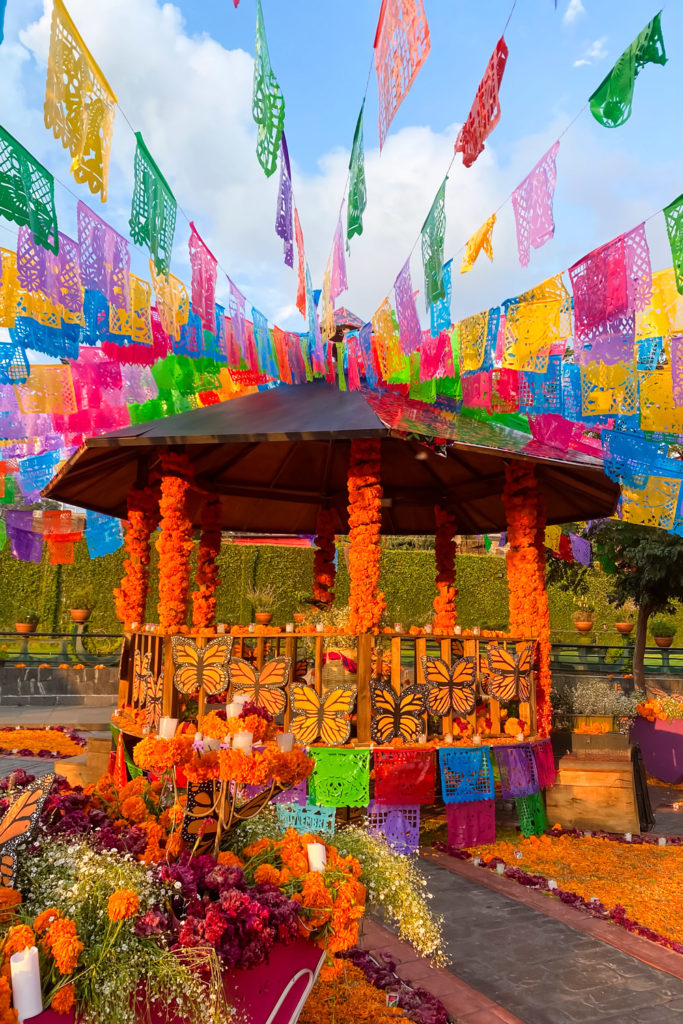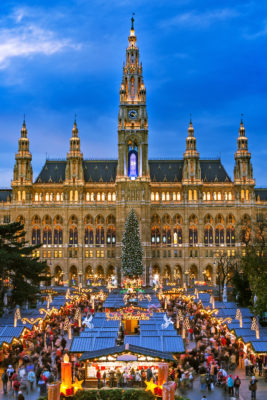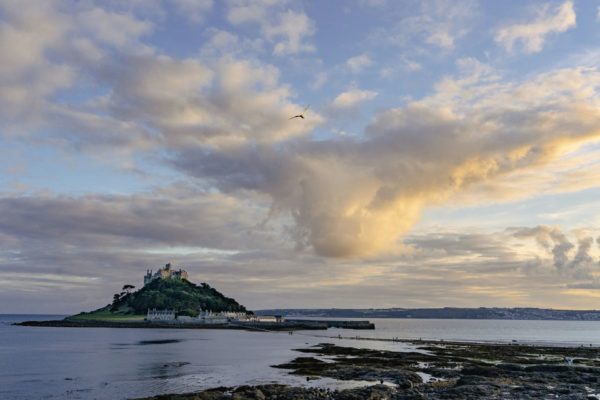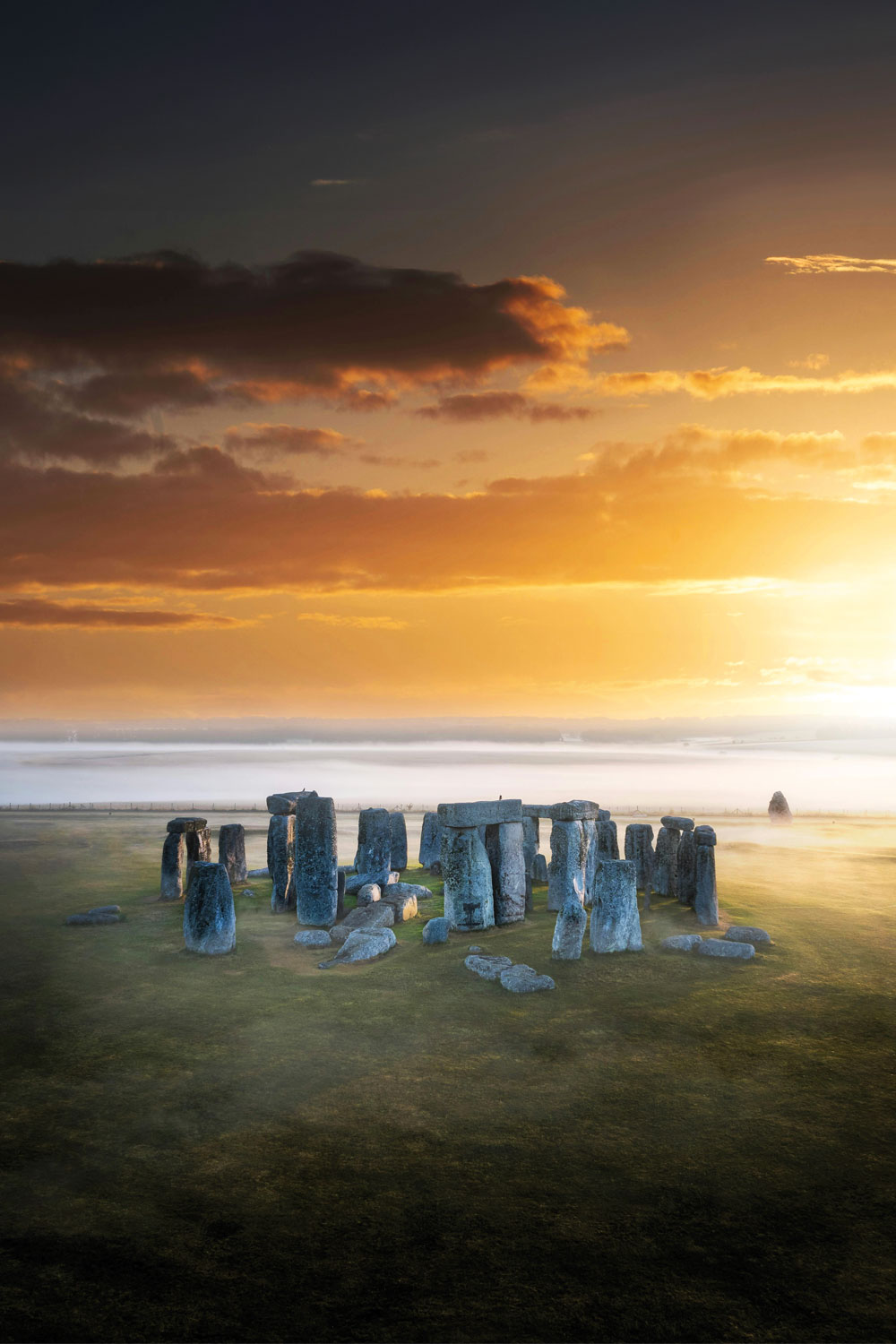
In Search Of Pagan Britain
By
1 year ago
Luke Abrahams discovers the old gods are still kicking about
Luke Abrahams journeys around the UK in search of pagan Britain.
Travelling In Search Of Pagan Britain
The story of these ancient islands we call Britain remarkably only began some 11,000 years ago. What had once been a cold, desolate and dry tundra on the northwestern edge of Europe gradually grew warmer as the mighty ice caps beyond the northern walls began to melt. Come 6,100 BC an ancient landlocked sea in Norway burst its banks triggering what scientists believe was one of the biggest tsunamis ever recorded on earth. Low-lying great plains – now the Irish and North Seas – and the marshlands of what would become the English Channel were violently swallowed whole. No, this is not the tale of Noah and his ark. This is the birth of a fabled island nation, and one that was to be forever eclipsed in a veil of mystery, sorcery and intrigue.
At the time, a fragile and extremely scattered population of hunter gatherers called the place home. Descended from the early humans of hundreds of thousands of years before, their arrival was perhaps by chance, led by migrating herds of mammoth and reindeer who they followed onto the peaks of Britain’s jagged and razor-sharp peninsula, says Neil Wilkin, curator of Early Europe at the British Museum. While everything remains hotly debated, proof of their existence is nothing more than a relic. Mere distant ancestors who forged our island’s destiny with their sea fearing exploratory spirit. Yet while the boggy pits of our rolling hills and eroding coastlines may have near wiped out all traces of their civilisation, one thing remains: the birth of Britain’s spiritual history.
Paganism. Say the word and thoughts of the Wicker Man and demon-worshiping cults slide into your vision. The media has often palmed them off as bushing loving forest bathing crazies, and they’re still stained with the ‘Satanic Panic’ of the 1980s when hideous tabloids whipped up nonsense hysterical headlines to sell newspapers. Let’s be clear: none burn people alive in the name of sacrifice; nor do they drink the blood of their enemies; taunt their sexually suppressed neighbours or have sordid orgies in the local pond. If there’s any stereotype modern pagans conform to, it’s your average hippy trope kind of folk you find in the depths of the crystal worshipping crowds at a summer festival.
As followers of the Christian faith plummets, the old religion including Wicca and Shamanism, as it were, is on the rise. The latest census statistics reveals as many as 126,000 Pagans currently live throughout the UK. And although there is no official doctrine, the question on many people’s baffled lips is, what is paganism? The overwhelming truth is simple: not much is known about the origin of prehistoric paganism other than what we can decipher from the mysterious monuments scattered across all corners of the British Isles. Much of it, as most researchers and experts agree, is ‘guess work,’ Neil reminds me in the museum’s staff canteen. What is known for sure though is that a pagan way of life is steeped within the natural cycles of the cosmos. Ideas of birth, growth and death align perfectly with the astronomically charged solstices and equinoxes, ancestor worship and ominous sacrificial rituals to the gods feature prominently, alongside a deep respect for the observable laws and elements that make up the natural world.
Much of the rest of our understanding of it all comes from a cultural prosaic vacuum thanks to a millennia of romantic myth and folk legends scribed from the legends of King Arthur and beyond. But for a country so obsessed with its origin myths, an air of taboo still plagues its sacred pagan sites. There are stone circles, henges, burial mounds, even an entire preserved village, but it was a culture so vastly misunderstood that history simply forgot and destroyed it…almost.
My pagan pilgrimage begins in Somerset, the spiritual hinterland of the ancient and modern pagan worlds. It was here several myths, legends and folktales were forged: the Oak Men of the haunted woods and the Giant Worm of Shervage Wood, to the more familiar tales of witches, hobgoblins, faeries and pixies that ran riot all the way down to the shores of Cornwall. Rising from this magical literary wasteland is The Newt in Somerset, wedged in between the so-called hills of Camelot and Glastonbury Tor. As you cross the boundary into the estate there’s an air of fleeting superstition fluttering about the place. Think of a parallel universe stuck in an almost infinite and invisible literary black hole-like time capsule. It’s eerily different here, and you feel it almost instantly.
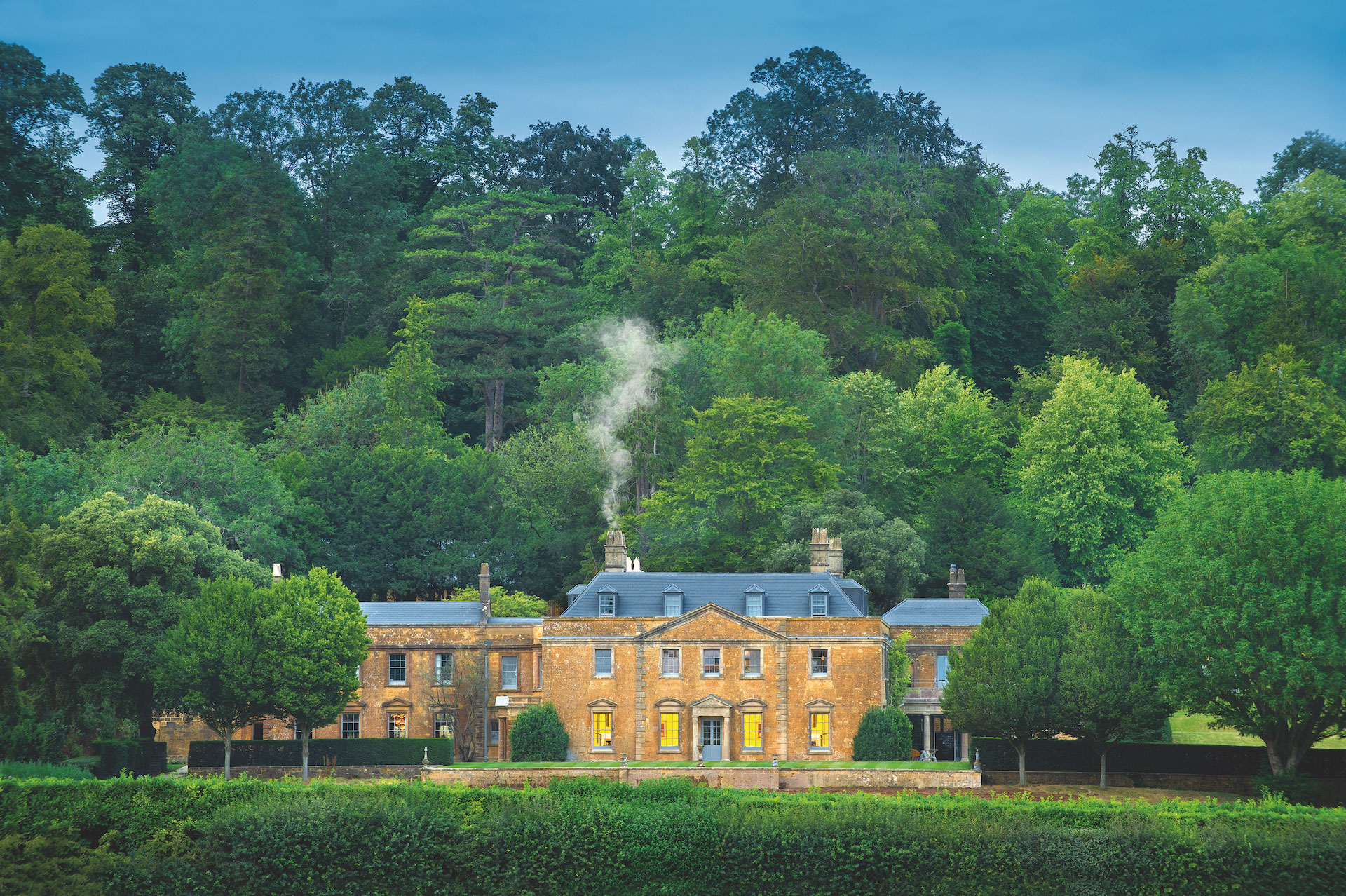
Hadspen House at The Newt
The hotel, famous not just for its storied Hadspen House, has made a name for itself for its cultural programmes suffused with the culture and history of Somerset county. Throughout the year celebrations include the annual fire festival and several harvest-themed bashes.
I’m here, however, to experience my first Wassail, a pagan ceremony normally only open to Newt employees and friends. Wandering in feeling somewhat like a poorly educated sacrificial lamb, the ancient ritual follows the waking up of the apple trees and the stirring of the senses. A giant marquee gilded with fairy lights stands in the middle of it all, surrounded by bales of hay, scolding torches and the headline act, crates of apples. Ushered in by the sound of drums and traditional song, the wassail King and Queen lead the procession to the boughs of a sacred tree. As the cries of wassail and incantations ring through the air, the queen places toast soaked in wassail from the clayen cup as a gift to the tree spirits. Following a final cry of wassail, fireworks crack and pop across the orchards and meadows, and with them, the hope of a great harvest the following season. They wake up.
As if by pre-ordained magic, the sun rises the next morning over the hills in near perfect unison with the now gleaming apple orchards of the estate. I meet Nicky, a witch, who first came to Glastonbury when she was seven and at that time became instantly involved in a pagan family. ‘I was taught witchcraft,’ she tells me as we walk around the estate with Arthur, the Newt’s exquisitely eccentric Head of Programmes. ‘You are taught the lore of the land, the power of the earth, the rocks, the crystals, and anything and everything that moves.’ Puzzled, I ask her what she means as we edge closer towards the estate so-called ‘Druid Tree’. Her pupils glimmer under her brilliant purple eye shadow and she then schools me in the art of witchcraft and pagan living.
‘It’s about understanding the innate powers of all the things that are invisible to us. It could be magnetism or magical mushrooms to some, but neither are considered supernatural beings. They are just part of the earth and over this time we’ve forgotten how to tap into them. We are gradually re-learning what our ancestors already knew all over the world.’
Among endless paths and herds of deer the Druid Tree appears. Cornered off by the clang of a gate, its magisterially nestled just off the trail that leads up to the Roman Villa. Its branches, shooting off in virtually every direction, are wiry, thick and aged. The trunk, almost godly in its proportions, and while its sheer size is foreboding, calmness ensues. ‘Touch it,’ Arthur says hugging it. There’s a warmth to it that sends shivers down my spine. Like a heartbeat, my searching hands pick up tremors that pulsate through its roots all the way up to its fresh spring-ready buds. I am confused. ‘It’s all about showing people there’s something deeper. We are just the conduit between all of these things, and we are making sense of it all.’
It’s this conduit state of mind that breathes itself into the mantras at Beaverbrook, my next stop. Stately and vast, Mother Earth informs much of the estate’s philosophies, especially in its wellness programs. Celtic rituals are not just for the spring solstice here in the Surrey Hills. Druidry is mainstream at the Beaverbrook Spa, but not in the gross, commercialised kind of way. ‘People now have a longing to reconnect and Druidry is all about finding a simpler way of living in the natural world around us,’ says spa director Rene van Eyssen during a brisk walk through the spa gardens. ‘Here, we really wanted to be authentic to the ancient spiritual traditions found in Britain, especially those found in Druidry which is all about a focus on mindfulness and spirituality.’
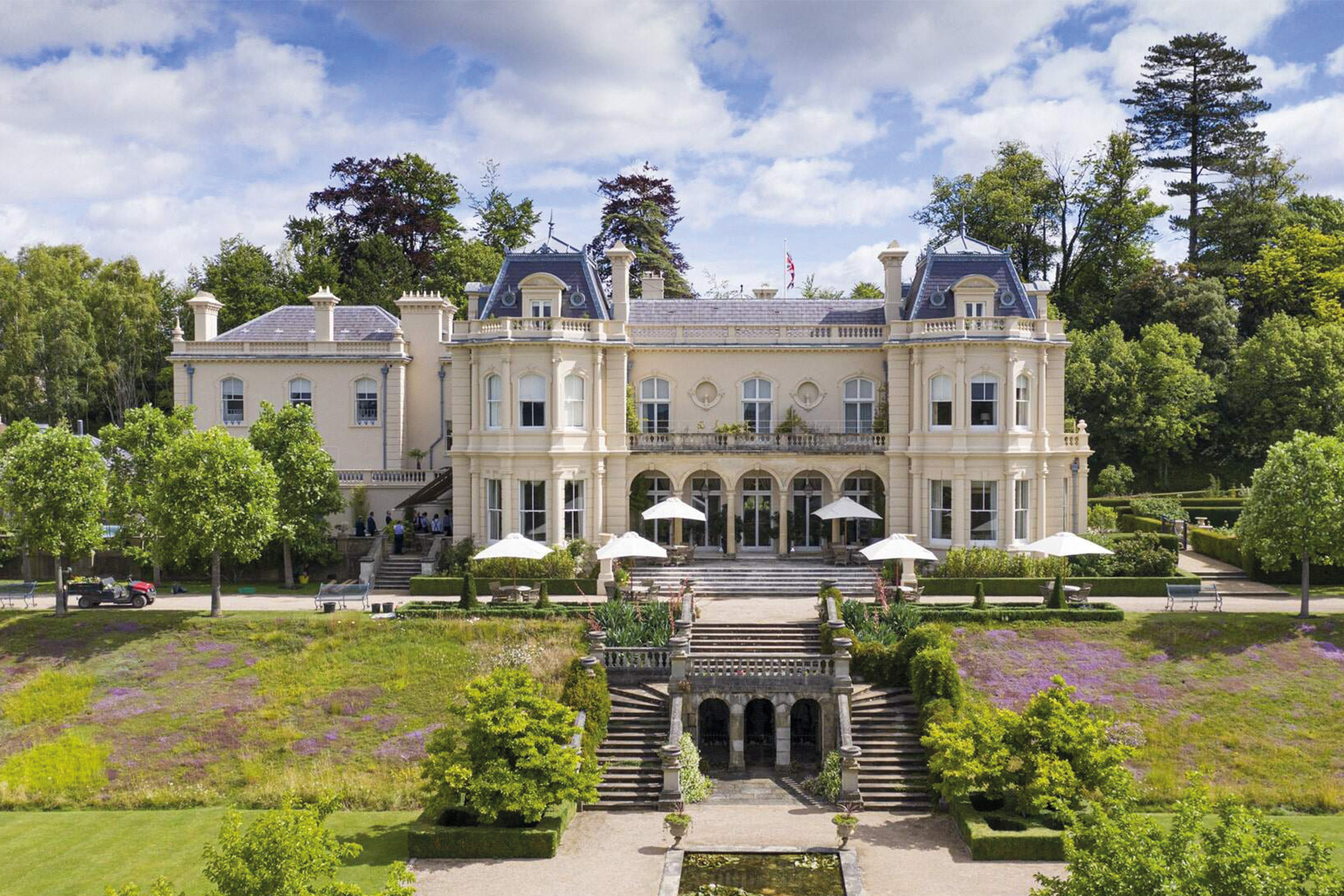
Beaverbrook
What the druids and Beaverbrook have most in common is their love of nature. Naturally, the hotel’s druid experiences changes with the seasons and the solstices. For me, it’s a spring-themed cleanse and grounding massage. Negative auras are banished with smoke and crystals and Lino, my Italian therapist, waltzes me through the Beaverbrook estate on a meadow walk that’s designed to gather and prick the senses. Ground you, and make you feel like a tree rooted to the the depth’s of the earth’s magnetising core. It’s in essence life coaching, through the ‘sacred’ sciences of a Druid’s staff. And it’s fabulous.
The druid trail eventually takes me to the small seaside town of Cardigan, a sleepy hollow where the historical monuments of paganism really shine. The small town is a bit of a technicolour dreamcoat. There’s a mish-mash of colourful facades, most of them local independent shops from run-of-the-mill boutiques to darling cafes. But perhaps its on the down low claim to fame is its informal role as the gateway to South Wales’ flourishing pagan monument scene.
On the river Teifi sits The Albion, sister hotel to fforest farm, an eco-savvy hip hybrid of Welsh farm and Japanese forest retreat, built for burnt out city folk looking to reset and get back to basics. The beauty of it all, despite the chic pads and maritime history is its deep connection to its pagan landscapes. Ewan Rees, an expert on Pagan Wales who works closely with the hotel, runs several walking tours designed to get guests up close and personal with the area’s pagan puts.
It all kicks off at Gors Fawr, a stone circle believed to be spiritually connected to Stonehenge. The circle is a curious mix; half the stones are bluestone, while the remainder are local glacial erratics. Near the circle are two outlying stones, which, local historians say align perfectly with the Carn Menyn rockface in the distance, the sacred spot where the Stonehenge bluestones are thought to have been foraged. Gors fawr, is the only true stone circle on the Priselis hills that is left. Young archelogist Delun Gibby tells me that, as with any site in this part of the world, not much is known about it. ‘It could be a calendar, a place for religious rituals or just a place where visiting tribespeople and agricultural societies would hang out to celebrate the changing of the seasons. With no written record, its sadly, difficult to tell.’
What is certain however is that the period up to the Bronze Age, around 4,000 years ago, was that structures like this first started to pop up all around the western fringes of Europe. Dolmens alongside prehistoric megalith burial chambers are some the earliest permanent structures built by people, some older than the great pyramids of Egypt. There are around 150 of these dolmens and ancient sites in Wales, the most notable spread across the Preseli Hills in Pembrokeshire.
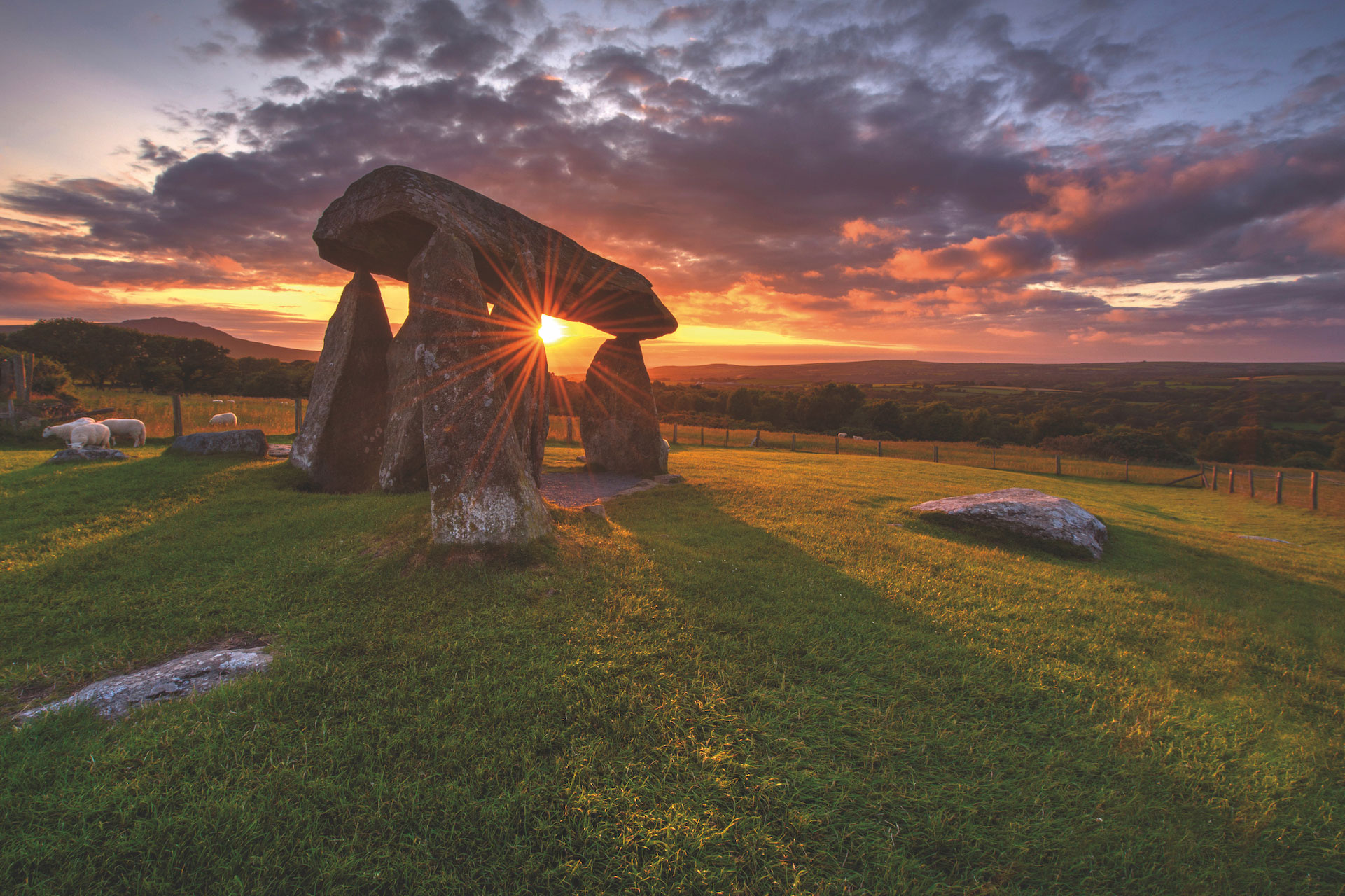
Pentre Ifan burial chamber
We first visit Foel Drygarn, an Iron Age Hill Fort during a brisk walk. Within its walls are at least 227 hut platforms and three stone cairns, said to be the remains of sacred Bronze Age burial mounds that spy stunning views of south Wales and the tip of neighbouring Ireland. Then there’s nearby Pentre Ifan, the largest and best-preserved necropolis in the region. The three standing stones and flat capstone have stood here for some 5,500 years, and when they were first erected would have been buried under a mound of earth. For many, including the tourists in search of Outlander landmarks, the fact some of these sites (many of them left unprotected) predates ancient Egypt blows their minds, including mine.
My prehistoric day out ends in Castle Henlyss, Britain’s only and finest example of an Iron Age village. The whole thing has been reconstructed on the exact location where roundhouses would have stood over 2000 years ago. As far as interactive experiences go, it’s a hoot. Typical days out expose you to the Demetae tribe who would have lived in this corner of Wales before, during and after the Roman Invasion in mud built huts. Inside each of the roundhouses the key workings of prehistoric life are explored, from the demonstrations of ancient skills and craft to kitchens, meeting habits and more. As with the stone circle, it’s all naturally guess work, but is designed to give you the most faithful picture of what Britian looked like before multiple invasions and the propaganda and complexities of Imperialism.
In Scotland, tales of paganism get even more culturally complex. I discover this during a four-day adventure aboard the Royal Scotsman, a Belmond Train. The journey is a masterclass in capturing the true essence of the country. Historic Edinburgh, the OG epitome of gothic Scotland, is where the four-day journey starts. As the train chugs out of Waverley Station, the hum and laments of bagpipes fills the air. Sitting in my Grand Suite, the spiritual laurels of the landscape come alive. Out from those great big windows, the grandeur of the Scottish capital slowly fades away as the train glides over the magnificent Forth Railway Bridge into the splendours of the far north. Glacial lakes gleam; tundras sparkle under a patchwork of wildflowers and sky-high mountains, from the western isles to the Cairngorms, pierce the stratosphere in all their magisterial glory.
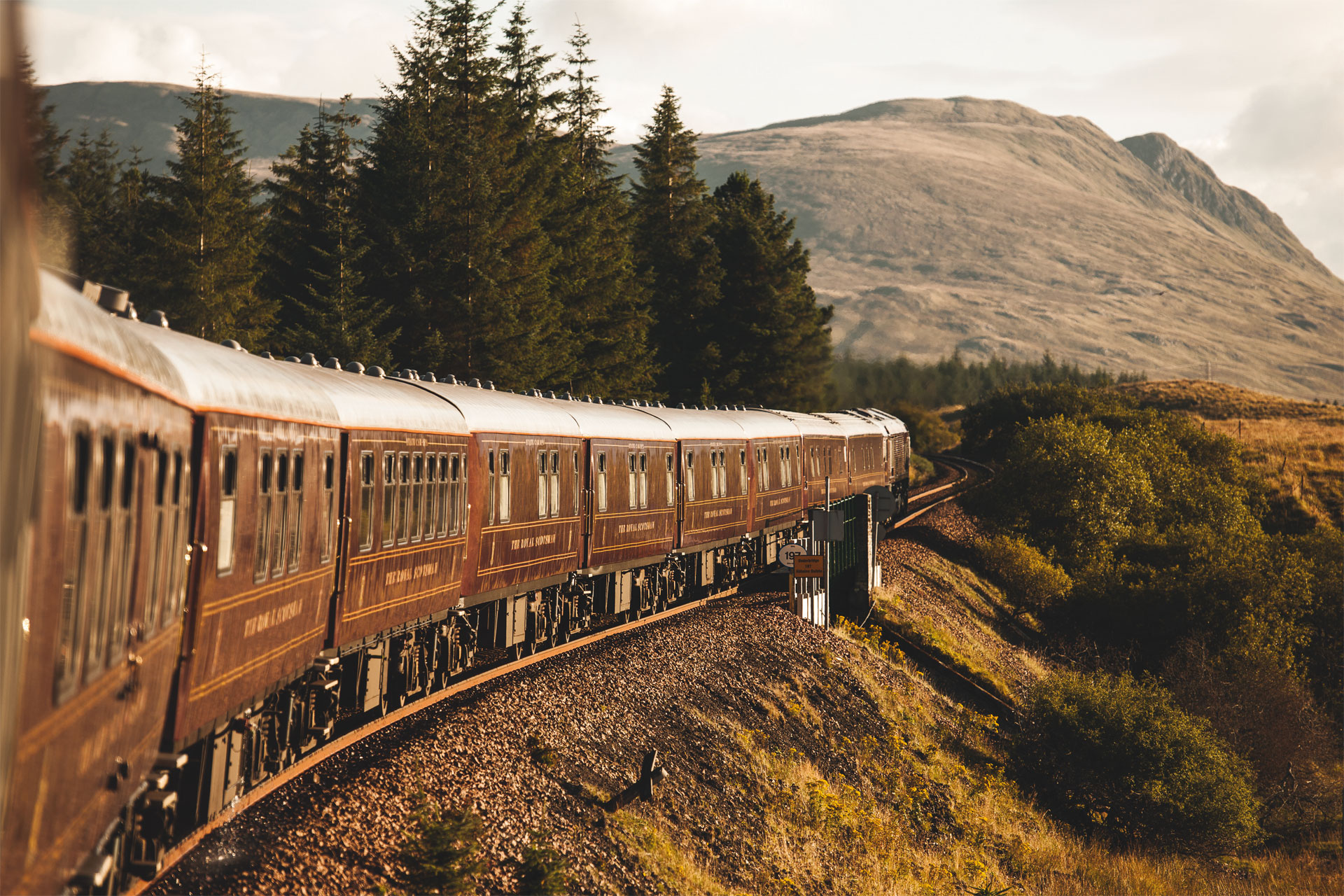
All aboard the Royal Scotsman
Days are spent at a sedate pace in between grand pit stops to the Kyle of Lochalsh, the Isle of Skye, the pretty town of Plockton and the Boat of Garten. The most fascinating soul I come across is Andrew Grant McKenzie, a highland historian that works closely with the Royal Scotsman. I first meet him out on a Drovers Walk, retracing the steps of his ancestors along the Allt an Dubh river, not far from Inverness. We visit all sorts, from ancient castles to the sites of witch trials, the picks (ancient Scots) and the Clava Cairns, one of the most sacred historic Bronze Age burial sites in Scotland. Over a traditional ploughman’s brunch, we talk legends and toy with the taboo subject of lost histories. Celtic invasions to the Romans and the terrible English crop into the conversation, but it’s the tale of the Loch Ness monster that grabs my attention most. ‘If you are thinking of deleted cultures and religions look at Saint Columba.’ Before the arrival of the Celts, much of Scotland was inhabited by the ancient Picts. They go back as far as the late third century AD and are assumed to be the descendants of the Caledonii and other northern Iron Age tribes, all of which would have followed pagan doctrine.
Archaeology, thankfully, gives some impression of their culture with evidence of a Pictish language scribed into several monuments throughout northern Scotland. Pictish was gradually displaced by Middle Gaelic as part of the wider Gaelicisation of the country from the late ninth century, and much of the cultural history displaced as a result of folk tales like the Loch Ness Monster. In short, and as Andrew tells me, it was a fable designed to terrify the locals: ‘if you didn’t convert to the new religion, you’d get eaten.’ And with that an entire culture and belief system was eradicated.
It’s this idea of lost histories that forms much of the basis of my final visit on this British odyssey, a night in The Cairngorms at The Fife Arms. Here I meet Natasha, a self-confessed herbalist so far infused with nature you might mistake her for Mother Earth herself. Working closely with The Fife, she’s tasked with taking guests out on foraging tours, and those yearning for a slice of nature and all its healing remedies.
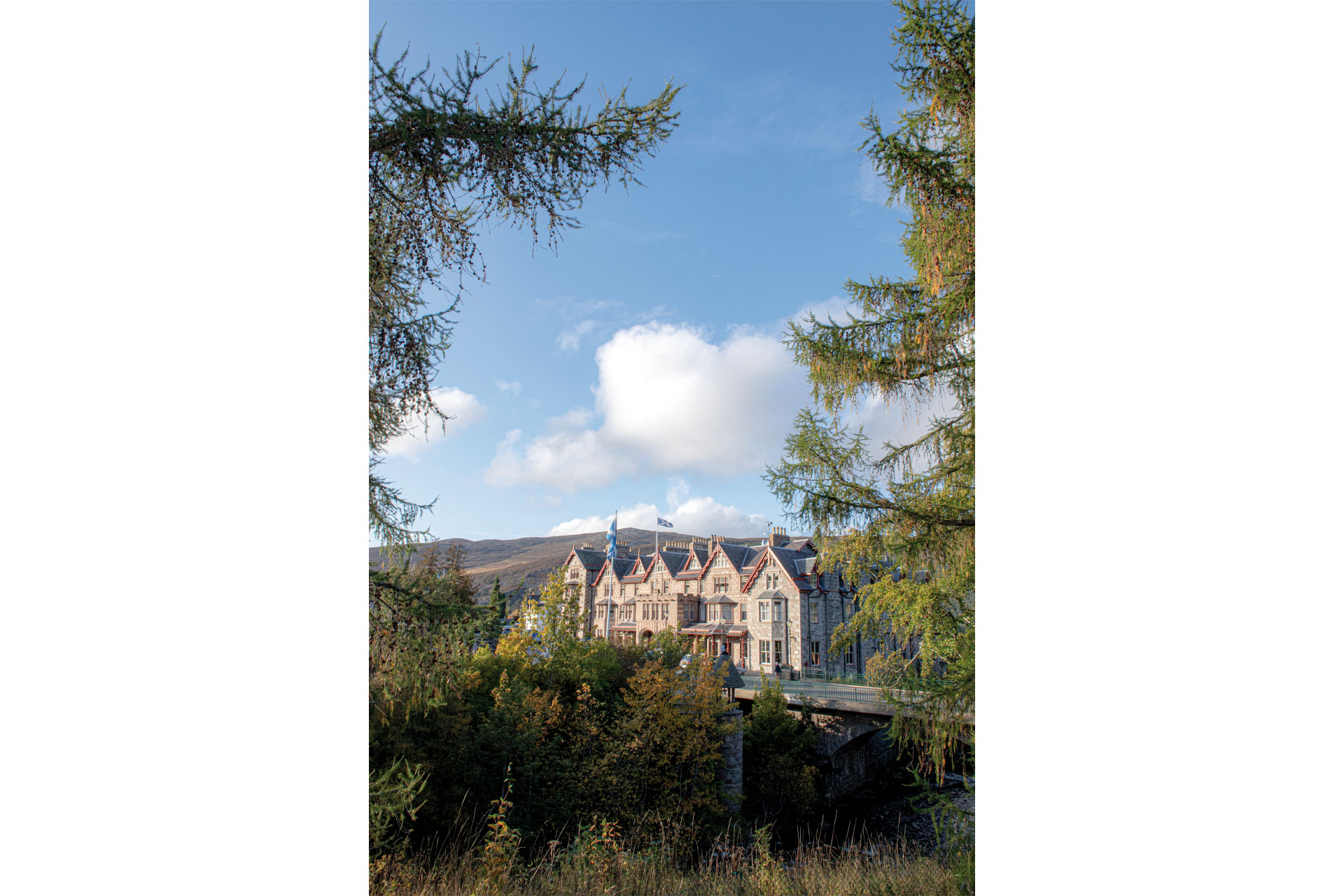
The Fife Arms
“I lived in the Hebrides for years and was taught various things from master teachers and shamans, including second sight. “My family are the Beatons that go back generations and are the physicians to the kings, so naturally, healing is part of my blood”, she tells me as we sit in the Picasso-flecked Drawing Room of the hotel. The herbalist practices are psychological and ritualistic here, and as Natasha laments, a way for guests to lose themselves and surrender to any element or form of control. Out in those grand hills that border the hotel all the way up to the Balmoral Estate, ‘it’s about allowing the flow of the universe to keep you for a moment and connect you as you explore nature’s wilderness.’
Foraging and getting them connected with the plants of the cairngorms and landscapes is second nature to the English expat who originally hails from Windsor. Explaining the stories behind these plants and how they can help you, medically and psychologically resonates from practically every aspect of her being. Before she leaves, Natasha reminds me that none of this is new.
‘All of these herbal traditions were lost because nothing was recorded or destroyed. It’s only because of our oral traditions in Scotland has our knowledge of the earth survived. It’s a beautiful network of people who have taught me the ways of the land. I am the modality, as are many others here and across the UK.’
The modern pagans really are the ones who are really keeping these oral and ancient cultural traditions of these islands alive. Like their ancestors before them they are grappling with many of the big questions we face today. Returning to the British Museum, Neil reminds me that, as a species, and as one race, there is now an intense interest in looking back to prehistoric life, particularly for those people in search of a sustainable and green existence lived much like our ancestors. Questions of, ‘how will we survive?’ And ‘who we are as a species?’ plagued prehistoric beings, and that’s perhaps the most pagan we are as a society today, Neil suggests.
There is Nathan, a property director who finds sanctuary on Little Singleton Farm in Kent teaching the ways of plant lore and floral artistry to day trippers; Sophie, a witch in Folkestone who comforts believers with tarot readings revealing their futures; and my neighbour, who trails the streets of Central London in search of wild flowers and herbs to add to the recipes of her ‘spell book.’ They walk between world’s bound to a perpetual state of magic, among the crowds in silence and in bittersweet matrimony with the universe. To them, and many more, the future of Britain is very much pagan.

